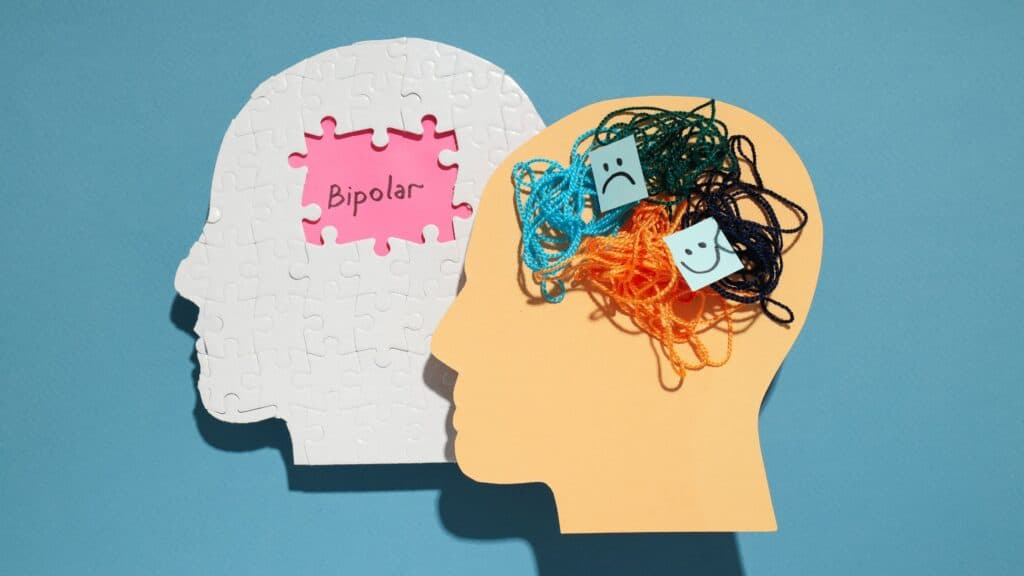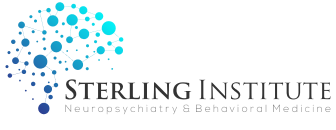At Sterling Institute of Neuropsychology and Behavioral Medicine, we understand the complexities and challenges associated with mental health disorders, particularly bipolar disorder. If find yourself wondering “Do I have bipolar disorder?” or you suspect you might have bipolar disorder, taking a preliminary self-evaluation can be a first step toward getting the help you need. This bipolar disorder test is a resource designed to help you assess your symptoms and guide you through understanding bipolar disorder, its symptoms, and available treatments.

Understanding Bipolar Disorder
Bipolar disorder is a complex mental health condition characterized by significant fluctuations in mood, energy, and activity levels. These fluctuations typically manifest as distinct episodes of mania (or hypomania) and depression, which differ significantly from a person’s typical mood and behavior.
Episodes of Mood Swings
Mood episodes in bipolar disorder include:
- Manic Episodes: Periods of excessively euphoric, energetic, or irritable mood that last at least one week. Symptoms may include inflated self-esteem, decreased need for sleep, being more talkative than usual, distractibility, and engaging in activities with a high potential for painful consequences.
- Hypomanic Episodes: Similar to manic episodes but less severe and without causing significant distress or impairing one’s work, school, or social life. They last at least four days.
- Depressive Episodes: Involve feelings of intense sadness, despair, or emptiness. During a depressive episode, individuals may experience a loss of interest in most activities, significant weight change, insomnia or excessive sleep, fatigue, feelings of worthlessness, and recurrent thoughts of death or suicide.
Symptoms of Bipolar Disorder
Bipolar disorder manifests through a wide range of symptoms, which can significantly vary in intensity and impact on daily life. These symptoms are categorized into two primary types of episodes: manic and depressive. Each type has distinct signs that affect mood, energy levels, behavior, and cognitive functions.
Manic Symptoms
Manic episodes involve an abnormally elevated, expansive, or irritable mood. Symptoms include:
- Increased energy, activity, and restlessness
- Excessively high, euphoric mood
- Extreme irritability and distractibility
- Racing thoughts and talking very fast
- Unrealistic beliefs in one’s abilities
- Poor sleep
Depressive Symptoms
Depressive episodes in bipolar disorder present with a markedly different set of symptoms, including:
- Feeling sad, empty, hopeless, or tearful
- Significant loss of interest in activities once enjoyed
- Significant weight loss or gain
- Either insomnia or sleeping too much
- Fatigue or loss of energy
- Feelings of worthlessness or excessive guilt
- Difficulty concentrating or making decisions
- Thoughts of death or suicide
Do I Have Bipolar Disorder? Quiz
Please note: This bipolar disorder test is not a diagnostic tool or a substitute for professional mental health advice.
Who Is The Bipolar Disorder Test For?
This self-assessment examination is specifically designed for individuals who experience mood fluctuations that impact their daily lives. It is intended for those who suspect they may have bipolar disorder based on observed changes in their mood, energy levels, or behavior.
While this bipolar disorder test can provide useful insights into your mental health, it is important to remember that it is not a diagnostic tool. It serves as an initial step for those seeking professional advice due to their symptoms.
How Accurate Is The Bipolar Disorder Test?
This bipolar disorder test is designed to help identify potential symptoms of bipolar disorder. It incorporates questions that target key indicators of the illness, based on general criteria used in clinical assessments. While the test draws on established guidelines for symptom identification, it is important to remember that it serves as an initial screening tool rather than a definitive diagnostic method.
We strongly recommend using the results of this bipolar disorder test as a starting point for a conversation with a mental health provider, who can then conduct a comprehensive assessment, confirm any diagnosis, and discuss appropriate treatment options tailored to individual needs.
Ready to begin your journey?
Contact Sterling Institute today to get started.
Factors That Can Impact Your Score
Be aware that external factors such as medication, other health conditions, and lifestyle can influence your quiz results. Substances like caffeine and certain medications can mimic or exacerbate symptoms of mania, while conditions like hypothyroidism can influence depressive symptoms.
Types of Bipolar Disorder
Understanding the different types of bipolar disorder can help in recognizing and treating the condition more effectively:
- Bipolar I Disorder: This type is characterized by manic episodes lasting at least seven days or by manic symptoms that are so severe that immediate hospital care is needed. Usually, depressive episodes occur as well, typically lasting at least two weeks.
- Bipolar II Disorder: Defined by a pattern of depressive episodes and hypomanic episodes, but not the full-blown manic episodes typical of Bipolar I Disorder. This type is often more chronic and involves more frequent mood swings than Bipolar I.
- Cyclothymic Disorder (Cyclothymia): A milder form of bipolar disorder involving numerous periods of hypomanic symptoms and depressive symptoms lasting for at least two years (one year in children and adolescents). The symptoms do not meet the diagnostic criteria for hypomanic and depressive episodes but are significant enough to impact daily life.
- Other Specified and Unspecified Bipolar and Related Disorders: This category includes bipolar disorder symptoms that do not match the three above categories but still cause significant impairment and distress.
Treatment Options for Bipolar Disorder
Effective treatment for bipolar disorder requires a personalized approach, as the condition manifests uniquely in each individual. Combining medication management with psychotherapy is considered the most effective strategy for controlling symptoms and improving quality of life.
Overview of Treatments for Mood Disorders
The most successful treatment plans for mood disorders like bipolar disorder are comprehensive, integrating pharmacological solutions and therapeutic interventions tailored to address the individual’s specific needs and symptoms.
Psychotherapy Approaches
- Cognitive Behavioral Therapy (CBT): This therapy helps patients identify negative thought patterns and behaviors and replace them with healthier ones. CBT is particularly effective in mitigating depressive symptoms and reducing the frequency of mood episodes.
- Interpersonal and Social Rhythm Therapy (IPSRT): IPSRT aims to stabilize daily rhythms such as sleeping, eating, and activity schedules. It helps patients develop a consistent routine that can significantly reduce mood swings and has been proven to have other positive effects on the course of bipolar disorder.
- Dialectical Behavior Therapy (DBT): DBT emphasizes mindfulness, emotional regulation, and stress management techniques. It is especially beneficial for individuals who experience intense emotional swings and impulsive behaviors.
Medications
- Mood Stabilizers: Medications like lithium, valproic acide, carbamazepine, and lamotrigine are approved treatments for bipolar disorder, helping to control manic episodes and helping to maintain a stable mood.
- Antipsychotics: Antipsychotics are sometimes used when symptoms are severe or do not respond adequately to mood stabilizers. Antipsychotics can be effective in treating both manic and depressive episodes. Some examples of these medications include
- Antidepressants: The use of antidepressants in the treatment of bipolar disorder is less common and a controversial topic amongst mental health professionals. However, sometimes, these medications are carefully used alongside mood stabilizers and antipsychotics to treat depressive episodes to prevent triggering a shift into mania.
Effective management of bipolar disorder often requires ongoing adjustment of the treatment plan, as the condition can change over time. Collaborating closely with healthcare providers ensures that treatments align with the patient’s evolving needs.
Speak to a Licensed Therapist at Sterling Institute
If you’re wondering “Do I have bipolar disorder?” or concerned about your mental health for any other reason, contact Sterling Institute in Danbury, Connecticut for a consultation. Our telehealth services provide convenient access to licensed therapists and psychiatrists in Connecticut, New York, and Florida who specialize in bipolar disorder and other mental health issues.
References
1. Jain A, Mitra P. Bipolar Disorder. [Updated 2023 Feb 20]. In: StatPearls [Internet]. Treasure Island (FL): StatPearls Publishing; 2024 Jan-. Available from: https://www.ncbi.nlm.nih.gov/books/NBK558998/
2. Geddes, J. R., & Miklowitz, D. J. (2013). Treatment of bipolar disorder. Lancet (London, England), 381(9878), 1672–1682. https://doi.org/10.1016/S0140-6736(13)60857-0
3. Frank, E., Swartz, H. A., & Boland, E. (2007). Interpersonal and social rhythm therapy: an intervention addressing rhythm dysregulation in bipolar disorder. Dialogues in clinical neuroscience, 9(3), 325–332. https://doi.org/10.31887/DCNS.2007.9.3/efrank
4. Nath M, Gupta V. Mood Stabilizers. [Updated 2023 Apr 24]. In: StatPearls [Internet]. Treasure Island (FL): StatPearls Publishing; 2024 Jan-. Available from: https://www.ncbi.nlm.nih.gov/books/NBK556141/
5. Zhang, Y., Yang, H., Yang, S., Liang, W., Dai, P., Wang, C., & Zhang, Y. (2013). Antidepressants for bipolar disorder: A meta-analysis of randomized, double-blind, controlled trials. Neural regeneration research, 8(31), 2962–2974. https://doi.org/10.3969/j.issn.1673-5374.2013.31.009
6. Rybakowski J. K. (2023). Application of Antipsychotic Drugs in Mood Disorders. Brain sciences, 13(3), 414. https://doi.org/10.3390/brainsci13030414

